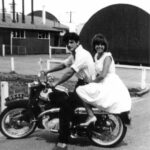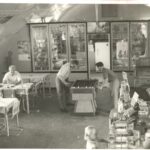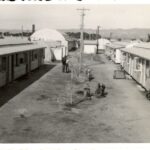In 1967 Glenelg was awarded Commonwealth Government ‘Hostel of the Year’. This was a far cry from the position in 1951, when an inspection revealed unsatisfactory conditions including a dirty kitchen and bathrooms, broken glass throughout the site and an area that gave ‘the impression of abandon’.
Place
Officially referred to as Glenelg North, the hostel off Warren Avenue had the advantage of being close to existing suburbs and shops. Residents were able to access public transport and visit the beach or the local cinema. Many children from the hostel attended the St Leonards Primary School.
Buildings from the old Royal Australian Air Force station at Port Pirie were recycled to establish the hostel, and the site was in operation from late 1949. In early 1950 the manager was still sleeping in a partitioned area off the dining room and staff were housed in dormitories while they waited for quarters to be built.
By March 1950 a second stage of building was approved, and some existing structures were altered to bring them into line with newly-established standards for Commonwealth hostels around Australia. Nissen huts were still being built well into 1951 when The Advertiser reported on progress, recording that migrants would move into new buildings ‘almost as soon as the paint is dry’. The completed hostel was to have the capacity to house 800 people, though numbers may never have reached that level.
If it was nice weather, especially in the summer, we’d go down to Glenelg North, to the beach. Mum was working, so then there would be other young girls in the hostel, who we used to meet, and there was a communal place, where we used to play. They used to have dances or play table tennis; I played table tennis every night. There would be movies, the old black and white, real old movies, open air. It was nice. And then we used to get together and just sit there and sing our German pop songs. Barbara Reis, Glenelg hostel 1955, interviewed 2013
Changes
In March 1953 Dutch migrants protested against conditions at the hostel, and later the same year police were called to the hostel when ‘European’ migrants threatened to pull down the recreation room after they were refused permission to hold a meeting there protesting against hostel rent levels. Glenelg hostel residents received the support of the Federal British Migrants Welfare Association, and the British Migrants Association, as British migrants joined the protests and rent strikes continued across Australian hostels.
Improvements continued throughout the 1950s, and Glenelg was eventually compared favourably to other migrant hostels by many residents. By the mid 1960s there had been a number of upgrades to buildings and infrastructure, and gardens had been planted. Glenelg also had a shop on site, which became a gathering place for a number of the single men.
In 1971 any residents who were not able to find private accommodation were transferred to Pennington hostel. Today one last Nissen hut remains on the site.
People
The first residents at the Glenelg hostel were predominantly Displaced Persons from Europe, with a number of people moved to Glenelg after Pennington was designated a British migrant hostel. Those housed at Glenelg expanded to include people from a range of European countries, including British migrants.
Families were living at Glenelg by 1953. Children attending St Leonard’s Primary School were a new challenge for teachers, who made special efforts to work with children learning English for the first time. A small number of children also attended St Mary’s Catholic School.
The Good Neighbour Council formed a Glenelg branch in 1950, and organised English lessons, socials, film evenings, concerts and special events for hostel residents. Christmas celebrations included presents from Father Christmas for children at the hostel.
A youth club formed at the hostel and organisations including the YWCA were active on site. Religious services were conducted by a number of different churches.
Throughout its lifetime it appears that the main appeal of the Glenelg hostel was that it was less isolated than many of the other migrant hostels, and this meant that residents had an earlier introduction to the wider community and could be more independent in exploring their new surroundings. People remember the social life of the hostel fondly, and there are several stories of lifelong friendships formed in the hostel.
By Dr Karen Agutter, the University of Adelaide, & Catherine Manning, Migration Museum
This entry was first published in the Hostel Stories: Migrant Lives exhibition at the Migration Museum (2013-2014), and appears here lightly edited and reformatted. It is based on research undertaken by the University of Adelaide supported by a Linkage Grant from the Australian Research Council (LP120100553) in partnership with the Migration Museum and a range of community partners.
Cite this
Dr Karen Agutter, the University of Adelaide, & Catherine Manning, Migration Museum, ‘Glenelg Migrant Hostel’, SA History Hub, History Trust of South Australia, https://sahistoryhub.history.sa.gov.au/places/glenelg-migrant-hostel/
Sources
The Advertiser, 4 December 1953, ‘Polish boy loved party’, p. 3
The Advertiser, 18 May 1953, ‘Police called to Glenelg migrant hostel’, p. 3
The Advertiser, 15 December 1954, ‘Christmas parties for new Australians’, p. 23
Agutter, Dr Karen, research notes, Hostel Stories project, the University of Adelaide
The Mail, 19 August 1950, ‘Manus huts at bay’, p. 16
The Mail, 13 January 1951, ‘Nissen hut frames make attractive pattern’, p. 10
Migration Museum, Hostel Stories: Migrant Lives, Glenelg Hostel information sheet.
Migration Museum, research files, Glenelg Hostel, Hostel Stories
State Library of South Australia, OH 948, Hostel Stories Oral History Project, JD Somerville Oral History Collection, 2010 – 2017
The West Australian, 28 May 1953, ‘Migrants at hostels get ultimatum’, p. 1
Links







Comments
23 responses to “Glenelg Migrant Hostel”
I would like to know why families who lived in the Finsbury Migrant Hostel 1950 were separated Women and children To Willaston and the men to Glenelg
Hi Cecilia, I believe the logic was that Willaston was well placed for the work men were being assigned to but Finsbury had more room and better accommodation. It was fairly common for men and women to be separated initially, with women and children being placed in the larger reception centres such as Bonegilla in Victoria or Woodside in the Adelaide Hills and men sent all over the country. For more detail I’d need to consult the researchers at the University of Adelaide (see the links section of this page for the research website). Not surprisingly families were keen to find work and accommodation that meant they could all live together, and this practice slowly stopped.
I lived at Glenelg North Hostel between Dec 64 & Dec 66, D12, Camp 2 – the part of the camp near Tapleys Hill Rd. Went to St Leonards.
Thanks for sharing your memories Neil.
I remember arriving at Glenelg at the age of 6 coming acrossthe Nullabore PlainfronPerth.The bakedbean sandwiches, wagonwheel and bottleof Fanta orange formy packed lunch at school. I hated the mornings when the Head mistress sang Here we go awandering through her microphone and we had to gallop or march in the play ground with all the parents laughing. We stayed 2 years and came home to Hull. Looking back, it was an adventure that has stayed with me all my life that I will never forget. Would I go back to Oz? No way, too hot for me and I’m too old now to take of all my clothes.
Thanks for sharing Jill, those sound like strong memories!
I arrived at the hostle on the 15th Dec 1962 with my two brother mum and dad and my little sister.I remember it was so hot . in side the huts that we went to the beach each day to keep cool. Ladies rom the locel church came around at christmas with a christmas cake which was very nice.
It must have been hot Doug! Thanks for sharing your memories.
What year did Fred and Betty Marshall arrive. ? Children Michael, Caroline, Barbra and Paula.?
Hi Jannette, if you’re looking to track specific records then the National Archives of Australia have a handy guide for researching migration history here – https://www.naa.gov.au/explore-collection/immigration-and-citizenship
I am from Malaysia and was in Adelaide from 1974 to 1978. First to do Matriculation in Norwood High School and later engineering at Adelaide Uni. We used to take the tram to Glenelg before we had cars. Later, I worked on weekends and some weekday evening at the St Leonard Inn saloon and front bar.
When I was doing my matriculation, I stayed in a boarding house on McGill Rd very close to the Maid and Magpie Hotel that were run by Russian Immigrant, Mr and Mrs Bolte. There were three Australians from country towns who were staying there and were doing their apprenticeship at the PMG. One of them was Rick and he had a Holden FH and we would drive around after tea. All very friendly people
Thanks for sharing those memories Malik, it sounds like you had an interesting time.
Hi, my family arrived at the Glenelg North hostel in August 1967. I was 4 but have some memories of playing with the other kids over the little hill that lead to the chain wire fence. Also the canteen/cafeteria and it’s smells, and the orange mugs with a pearly finish, and there was a juice drink that tasted strange to me. I was wondering who owns it now? I would like to get their permission to photograph the remaining building and the site (for my photography course)….I have photos of the gated entrance but don’t want to be trespassing. Cheers.
Hi Sheila,
I believe the land is now part of the Adelaide Airport complex. There are some photos up on Flickr of the site more recently –
https://www.flickr.com/photos/migrationmuseum/10525510844/in/pool-migran…
https://www.flickr.com/photos/migrationmuseum/10525511204/in/pool-migran…
My family migrated to Australia from Switzerland in June 1964 and after a brief stay at Bonigilla, we were transferred to Glenelg Hostel. My mum worked in the cafeteria, my Dad also found employment and rode a bicycle to Parkside each day to work. I attended St Leonards Primary, I did not speak English and I remember looking blankly at the menu board for my school lunches, first time I tasted fritz and was disgusted at the chemical taste….then I found vegemite which was close to something we had in Switzerland and I had that every day, not wanting to risk any other choice 😀 . I have fond memories of my time there, making friends, walking to school and attending some craft classes at the Hostel. We were there for about 6 months and then bought a house in what was then called Centennial Park.
Thanks for sharing your experiences Florence.
I lived at Glenelg Hostel in 1966. I was 4 and our family was 5. We came to Australia on the Fairsky boat (an amazing trip I will never forget). I remember playing on a huge slide there and rolling around in massive muddy puddles. I enjoyed life there and there were lots of workman building new housing. I was very young but remember the small rooms, the canteen, kids playroom and huge areas to play. Also it was very hot and I got sunburnt often. My name is Shirley, brother Tom and sister June. Mum Jessie and father Tom Henderson.
Thanks for sharing Shirley, it sounds like quite an adventure.
Hi Shirley, interesting story. You were probably on the same ship as my family, and I was five years old. We got off the ship in Melbourne and went to the Geelong hostel. Shirley, if you were in Glenelg in 1966, you must have heard the news of the missing Beaumont children. It must have been a big deal back then.
I lived in the Glenelg hostel for 18 moth in 1955-56, yet there seem to be no mention of that time in any of the posts.
I remember having more than 10 room-mates as I was at times on my own in the room, and then a married man would move in for a few a few weeks until there was some room in the hostel to bring his family from Woodside to the hostel
Thanks for sharing your memories Willibald. This is just a short introduction to the history, there are so many more stories that could be included. In the links section above is the project site for The University of Adelaide Hostel Stories research if you’re interested in finding more information.
I lived with my parents and older sister at the Glenelg hostel in 1963. I was 7 yrs old, my sister 9 yrs.
We were migrants from the UK.
I remember the old bent gum tree which was still a living tree at the time.
We went to school at st Leonard’s.
My first experience of huge three corner jacks, going barefoot and having to negotiate a prickly path to the Nissan hut we called home.
There was a playground with a large slide.. where I broke my arm trying to shimmy up the back of the slide.
There were sand dunes and we used to slide down on bits of cardboard.
Not a lot of parental supervision: we would go down to the beach by our selves, play in the dunes by ourselves, often older children would take advantage of that situation.
My parents worked hard and we left for Melbourne after about a year.
Glenelg was my first experience of Australia, the heat, the dryness, the harsh landscapes the smell of Sunlight soap, Vegemite, gum trees, ants, I can’t say I was sad to leave but the experience remains one of my most vivid recollections of coming to Australia.
Such evocative memories Dani, they clearly are vivid! Thanks for sharing here.